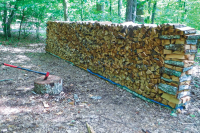Up Moses Creek: A Siphon Does Not Sip
 The pond spring flows boldly during an extra-wet March.
Burt Kornegay photo
The pond spring flows boldly during an extra-wet March.
Burt Kornegay photo
Ready?” I shout over my shoulder up towards the pond. I am straddling the end of a long, white plastic pipe filled with water, its end taped shut with a wrap of 5-mil plastic.
The plastic bulges out like a hernia from the pressure of the water in the pipe. Behind me, the pipe angles up to the pond, where it crosses the embankment, then turns back down and disappears into the water on the other side.
“Ready!” I hear Becky shout back from the far side of the pond. I can’t see her, but I know she’s got a tight grip on a rope that disappears into the water too, where it’s tied to a plastic seal on the submerged end of the pipe.
Before we took our places, we’d filled the entire pipe with water, turning it into a kind of water cannon, primed.
“Go!” I yell.
Becky yanks the seal off her submerged end of the pipe, and, at the same instant, I slit open the bulging plastic on my end with a knife—then leap back as the pent-up water shoots out as if from a fire hydrant and rushes down into the woods.
Related Items
It is the start of our annual pond drawdown to clean out the accumulation of fallen leaves and debris. The pipe gushes water so hard that the pond — the size of a swimming pool — immediately begins to drop.
Draining the pond was not always this easy. Years back, I used to rent a heavy-duty “trash pump” to do the job. The machine was costly. I had to haul it from Sylva. It was so heavy I needed a stout worker to help me set it in place. Cranked up, it was lawn-mower loud. And the gaseous thing took four hours to empty the pond — that is, when it didn’t lose its prime repeatedly or break down.
If only I’d listened early on to a Moses Creek neighbor named Dick. When I asked him how to drain the pond, he said, “Use a siphon.”
Finally, after cursing at trash pumps for years, I remembered Dick’s advice and looked into siphons. I learned that “siphon” is an ancient Greek word meaning “tube” and that the Greeks used them 3,000 years ago to pipe water. A modern engineering article explained that atmospheric pressure combined with gravity forces the water up the pond end of the siphon pipe, over the embankment, and back down and out the pipe’s longer, lower end.

So, buying the lengths of pipe and fittings needed, then assembling them and priming the siphon for the very first time — wondering what would happen when we opened up the ends — we saw it drain the pond in one effortless hour. In that hour, I realized how right Dick had been, and I became an ancient Greek. Call me Burtocles.
This is our sixth year siphoning the pond. There’s no renting a gas pump; we simply assemble the pipe. There’s no pulling on a starter rope until my arm is rubbery. And the siphon is quiet.
Here’s the best thing of all. With a trash pump, we had to rake the waterlogged leaves away from its intake to keep the pump from clogging. But with the siphon? Like a thirsty gullet, it sucks in everything we feed it, while out its lower end shoots a brown sludge of rotten leaves. Good thing we don’t stock the pond with fish or they’d go out too. We use it for swimming instead.
Drawing down a pond is a practice as ancient as using a siphon. It puts cleansing sunlight on the bottom, and it lets us remove the rotting leaves that fertilize algae growth. We leave enough water for the salamanders to survive.
Also, because wood frogs (“Rana sylvatica”) mate in the pond in mid-winter, we scoop into tubs the gelatinous egg masses they leave behind. When the pond refills, the water tops the tubs, and the hatched tadpoles swim out.
The pond is fed by a spring that flows with just a “pinkie” of water. But in 24 hours, a pinkie-flow adds up to 600 gallons. Also, buried pipes conduct rain from the metal roofs of our house and shelter to the pond. One inch of rain on the roofs puts in 2,000 gallons. The fastest the pond ever refilled was in 2 days, during an extra rainy March. This March it took 2 weeks.
Thank you, Neighbor Dick, for watering my ancient Greek roots!
(Burt and Becky live in Jackson County. “Up Moses Creek” comes out in SMN the second issue of each month.)













